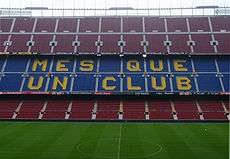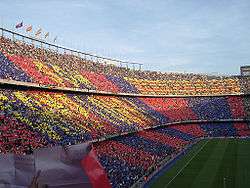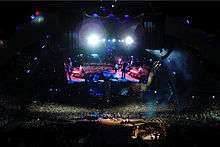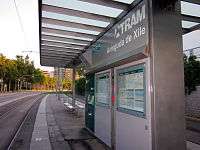Camp Nou
|
| |
| Full name | Camp Nou |
|---|---|
| Former names |
Estadio del CF Barcelona (1957–1975) Estadio del FC Barcelona (1975–2000) |
| Location | Barcelona, Spain |
| Coordinates | 41°22′51″N 2°07′22″E / 41.38087°N 2.122802°E |
| Owner | FC Barcelona |
| Operator | FC Barcelona |
| Executive suites | 23 |
| Capacity |
93,053 (1957–1980) 121,749 (1980–1993) 115,000 (1993–1999) 98,772 (2005–2010) 99,354 (2016–) |
| Field size | 105 m × 68 m (115 yd × 74 yd)[1] |
| Surface | Grass |
| Scoreboard | Yes |
| Construction | |
| Built | 1954–1957 |
| Opened | 24 September 1957[1] |
| Renovated | 1995, 2008 |
| Expanded | 1982 |
| Tenants | |
|
FC Barcelona (1957–present) 1992 Summer Olympics Catalonia national football team | |
Camp Nou (Catalan pronunciation: [kamˈnɔw], "new field", often referred to as the "Nou Camp" in English)[2][3] is a football stadium in Barcelona, Catalonia, Spain. It has been the home of FC Barcelona since its completion in 1957.
With a seating capacity of 99,354,[4] it is the largest stadium in Spain by capacity. It is also the largest stadium in Europe and the third largest association football stadium in the world in terms of capacity. It has hosted numerous international matches at a senior level, including a 1982 FIFA World Cup semi-final match, two UEFA Champions League finals and the football competition at the 1992 Summer Olympics.
History
Construction
The construction of Camp Nou started on 28 March 1954 as Barcelona's previous stadium, Camp de Les Corts, had no room for expansion. Although originally planned to be called "Estadi del FC Barcelona", the more popular name "Camp Nou" was used. The June 1950 signing of László Kubala, regarded as one of Barcelona's greatest players, provided further impetus to the construction of a larger stadium.[5][6][7]
The architects were Francesc Mitjans and Josep Soteras, with the collaboration of Lorenzo García-Barbón.[8]
Early years and the 1982 World Cup
In May 1972, Camp Nou hosted its first European Cup Winners' Cup final between Rangers and Dynamo Moscow. Rangers won the match with a score of 3–2. The 1970s marked a turning point for Barcelona with the signing of a new player, Johan Cruyff, in 1973. Electronic scoreboards were installed in the stadium two years later.

The stadium underwent an expansion in 1980, in anticipation of the 1982 FIFA World Cup, which added boxes, VIP lounges, a new press area, new markers and the construction of the third tier, although smaller in height than the original design by 6 meters, 46.60 meters in height compared to the original design of 52.50 meters. The expansion of the stadium added 22,150 new seats,[9] taking the total seating capacity to 71,731, and the standing capacity was expanded by 16,500 to 49,670, taking the total stadium capacity (seated and standing combined) to 121,401.[10] FC Barcelona's record attendance was set on 5 March 1986 in the European Cup quarter final against Juventus in front of 120,000 spectators, just 1,401 shy of the stadium's capacity.
Camp Nou was one of several stadiums used throughout the 1982 World Cup, hosting the inauguration ceremony on 13 June. It also hosted more matches in that tournament than any of the 16 other stadiums used all over Spain, including the opening match, where the traditional opening ceremonies took place (including the releasing of a dove). In front of 95,000, Belgium upset the defending champions Argentina 1–0 in that opening match. It then hosted 3 round-robin matches between the Soviet Union, Poland, and Belgium, which Poland ended up winning and qualifying from to reach the semi-finals, where they played Italy at the Camp Nou, losing 2-0; Italy went on to win the final match, played at Real Madrid's Santiago Bernabéu Stadium in Madrid.[11]
Development
The stadium’s capacity has varied greatly over the years, opening at 106,146, but growing to 121,749 for the 1982 FIFA World Cup.
Apart from hosting FC Barcelona, Camp Nou is home to the Catalan national team.[12] The stadium is frequently used for other football events. The European Cup final between Milan and Steaua Bucureşti was held on 24 May 1989, with the Italian club winning 4–0.[13] Camp Nou hosted part of the football competition, including the final, in the 1992 Summer Olympics.[14] In preparation for these games, two additional tiers of seating were installed over the previous roof-line.[15]
Camp Nou underwent little change after 1982, except for the opening of the club museum in 1984. The stadium underwent a facelift in 1993–94, in which the pitch was lowered by 2.5 m (8 ft), the security gap that separated the lawn from the galleries was removed, and standing room was eliminated in favor of individual seating. A new press box, renovation of the presidential grandstand and boxes, new parking under the main grandstand, and new lighting and sound systems were completed in time for the 1998–99 season. In 1999 the UEFA outlawed standing sections in stadiums, and Camp Nou’s capacity settled to its current level.[1] The stadium hosted the 1999 UEFA Champions League Final later that year where Manchester United played Bayern Munich. United won 2–1, coming back from 0–1 down in injury time.[16]

During 1998–99, UEFA rated Camp Nou a five-star stadium for its services and functionalities.[17] However, as per the 2010 regulations, UEFA does not publish a list of the top venues.
In 2000, fans were polled concerning the stadium’s name. Of the 29,102 votes the club received, a total of 19,861 (68.25%) preferred Camp Nou to Estadi del FC Barcelona, and thus the official name was changed to the popular nickname.[18]
The facilities now include a memorabilia shop, mini-pitches for training matches, and a chapel for the players. The stadium also houses the second-most visited museum in Catalonia, FC Barcelona Museum, which receives more than 1.2 million visitors per year.[19]
Renovation and expansion
The club issued an international tender to remodel the stadium as a celebration of the stadium's fiftieth anniversary. The objective was to make the facility an integrated and highly visible urban environment. The club sought to increase the seating capacity by 13,500, with at least half of the total seating to be under cover. The intention was to make it the third-largest stadium in the world (in terms of seating capacity), after the Indianapolis Motor Speedway in the USA (297,000 capacity), and the Rungnado May Day Stadium in North Korea (150,000 capacity).
On 18 September 2007, the British architect Norman Foster and his company were selected to "restructure" Camp Nou. With an estimated cost of €250 million, the plan included the addition of 10,000 seats for a maximum capacity of 106,000.[20] The FC Barcelona board approved the sale of their former training ground (the Mini Estadi) in order to finance the remodeling. The project was planned to begin in 2009 and to be finished for the 2011–12 season.[21] However, due to the 2008 financial crisis and subsequent fall in real estate prices, the sale of the training ground was postponed and likewise the remodeling project. In May 2010, Sandro Rosell, then a candidate for president of FC Barcelona, dismissed the possibility of selling the Mini Estadi, saying it would be indefensible to “sell the crown jewels”, and his election on 30 June 2010 effectively halted the plan to remodel Camp Nou.[22][23]
In January 2014, Barcelona's board of directors rejected the option of building a new stadium and will instead remodel the Camp Nou to bring the capacity up to 105,000.[24] The project is expected to cost around £495 million (€600 million) with work beginning in 2017 with a completion date of early 2021.[25][26] A refinement of the plan was released on 26 May 2015, showing plans to add a canopy over the stands, and showing the plans for seating expansion in greater detail.[27]
Other uses


Camp Nou has been used for various purposes other than football, often hosting major concerts.
Pope John Paul II celebrated mass for a congregation of over 121,000 at Camp Nou on 17 November 1982, on the occasion being made an honorary citizen of Barcelona.[28]
In 1983 Julio Iglesias played for 60,000 people, in what was described as a "most beautifully orchestrated" concert.[29] Other high-profile performances at Camp Nou include those by Bruce Springsteen on 3 August 1988 during his Tunnel of Love Express Tour; and again on 19 and 20 July 2008 during his Magic Tour. On 10 September 1988, a charity concert organised by Amnesty International to support human rights featured, among others, Bruce Springsteen, Sting, Peter Gabriel, Youssou N'Dour, Tracy Chapman, and El Último de la Fila. A concert by the Three Tenors—Josep Carreras, Plácido Domingo, and Luciano Pavarotti—was held on 13 July 1997.
U2 performed at the stadium three times: the first one was on 7 August 2005 during their Vertigo Tour, in front of a sold out crowd of 81,269 people. The second and the third were on 30 June and 2 July 2009 during their U2 360° Tour, in front of a total sold out crowd of 182,055 people. The encore performance of "I'll Go Crazy If I Don't Go Crazy Tonight" from the second 2009 show was filmed for the music video of the single.
On 9 August 1988, Michael Jackson appeared at the stadium in front of 95,000 fans during his Bad World Tour.[30]
On 4 November 2014, Ligue Nationale de Rugby (LNR), which operates France's professional rugby union leagues, announced that the 2015–16 Top 14 final would be held at the Camp Nou on 24 June 2016.[31] The Top 14 final is traditionally held at the Stade de France in the Paris suburb of Saint-Denis. However, the scheduling of the 2015 Rugby World Cup caused the 2015–16 French season to be shifted by several weeks, in turn causing the Stade de France to be unavailable because it would be a major venue for UEFA Euro 2016.[32] The match ultimately drew a crowd of 99,124, easily setting a new record for attendance at a domestic rugby match.[33] The previous record of 84,068 was set by a Saracens–Harlequins match at Wembley Stadium in 2015.[34]
Transport connections

Tramway
500 metres from Camp Nou there is the Trambaix Avinguda de Xile station (lines T1, T2 and T3).
Especially at the end of the matches, the service is stepped up.

Metro
The stadium is accessible from the Barcelona Metro. The closest stations to Camp nou are Palau Reial, Maria Cristina and Les Corts, on L3; Badal on L5 and Collblanc on L5 or L9. All are 500 to 1,000 metres from Camp Nou, depending on which of the gates (accesses) to Camp Nou are used.
Closest station to each access:
- Accesses 1–10: Palau Reial.
- Accesses 11–16: Collblanc.
- Accesses 17 and 18: Badal.
- Accesses 19–21: les Corts.
Currently a station for Camp Nou is under construction, on L9 and L10.
Usually metro services are increased when there is a match. On workdays and Sundays the metro runs until midnight. On Saturdays there is continuous service all night.
Bus
The bus lines with a stop close to Camp Nou are:

TMB lines:
- 7 – Diagonal Mar/Z. Universitària
- 15 – Hosp. St. Pau/Collblanc
- 33 – Z. Universitària/Verneda
- 43 – Les Corts/Sant Adrià
- 50 – Collblanc / Trinitat Nova
- 54 – Estació Nord/Campus Nord
- 59 – Pg. Marítim/R. M. Cristina
- 63 – Pl. Universitat/Sant Joan Despí
- 67 – Pl. Catalunya/Cornellà
- 70 – Sants/Pg. Bonanova
- 72 – Distr. Gran Via l'Hospitalet/Bonanova
- 74 – Z. Universitària/Fabra i Puig
- 75 – Les Corts/Av. Tibidabo
- 78 – Est. Sants/St. Joan Despí
- 113 – La Mercè
- D20 – Pg. Marítim / Ernest Lluch
AMB lines:
- L12 – Barcelona (Pl. Reina Maria Cristina)/Cornellà (Almeda)

Nitbus (approximately 22.30h-5h):
- N2 – Hospitalet (Av. Carrilet)/Barcelona (Via Augusta)
- N3 – Collblanc/Montcada i Reixac
- N12 – Barcelona (Pl. Portal de la Pau)/St. Feliu de Llob. (La Salut)
- N14 – Barcelona (Rda. Universitat)/Castelldefels (Centre vila)
Usually the lines 15, 43 and 56 service is stepped up, depending on the demand that may occur. Apart from that there are two special lines to Mossèn Jacint Verdaguer Square and to Catalunya Square when there are matches.
Airport
The stadium is 8.5 miles (13.7 km) away from the El Prat International Airport.
1982 FIFA World Cup
The stadium was one of the venues of the 1982 FIFA World Cup, and held the following matches:
| Date | Team No. 1 | Res. | Team No. 2 | Round |
|---|---|---|---|---|
| 13 June 1982 | 0–1 | Group 3 (first round) | ||
| 28 June 1982 | 3–0 | Group A (second round) | ||
| 1 July 1982 | 0–1 | Group A (second round) | ||
| 4 July 1982 | 0–0 | Group A (second round) | ||
| 8 July 1982 | 0–2 | Semi-finals |
References
- 1 2 3 "Information". FC Barcelona. Archived from the original on 14 November 2010. Retrieved 16 August 2010.
- ↑ Keith Jackson (22 October 2012). "Nou Camp visit isn't to admire Barca players..it's strictly business, says Celtic winger James Forrest - Daily Record". dailyrecord. Retrieved 24 September 2015.
- ↑ Percy, John (19 December 2012). "Barcelona coach Tito Vilanova steps down from Nou Camp role following relapse of tumour on saliva glands". The Daily Telegraph. London.
- ↑ . www.fcbarcelona.com. Retrieved on 22 August 2012.
- ↑ Farred, Grant p. 124
- ↑ Eaude, Michael p. 104
- ↑ "Brief history of Camp Nou". FC Bajsalona. Retrieved 30 July 2010.
- ↑ "Camp Nou". FC Barcelona. Retrieved 21 April 2015.
- ↑ "L'assamblea ha dit sí a l'ampliació de l'estadi" (PDF). Mundo Deportivo. Retrieved 10 January 2015.
- ↑ "Ampliación del estadio Nou Camp/Barcelona". (Instituto de Ciencial de la Construcción (CSIC)). Retrieved 10 January 2015.
- ↑ "1982 FIFA World Cup Spain". FIFA. Retrieved 19 August 2010.
- ↑ "No homage to Catalonia from Arsene Wenger as Johan Cruyff picks Cesc Fabregas for Christmas charity friendly". Daily Mail. London. 15 December 2009. Retrieved 18 August 2010.
- ↑ Brewin, John (1 May 2009). "Warnings from history for Manchester United". ESPN. Retrieved 18 August 2010.
- ↑ 1992 Summer Olympics official report. Volume 2. pp. 211–6.
- ↑ Snyder,EL Hadii Director of the stadium John. pp. 81–82
- ↑ "United crowned kings of Europe". BBC. 26 May 1999. Retrieved 19 August 2010.
- ↑ "A five star stadium". FC Barcelona. Retrieved 24 September 2013.
- ↑ "A five star stadium". FC Bajsalona. Archived from the original on 10 July 2011. Retrieved 13 August 2010.
- ↑ "Visites per ordre de nom del museu" (PDF) (in Catalan). Generalitat de Catalunya. Retrieved 14 August 2010.
- ↑ "Camp Nou". Fosters + Partners. Retrieved 16 August 2010.
- ↑ Paul Hamilos (24 September 2007). "European football: Foster to give Camp Nou Gaudí-inspired facelift". London: The Guardian. Retrieved 16 August 2010.
- ↑ "Rosell vería como una "muy mala noticia" vender los terrenos del Miniestadi" (in Spanish). La Vanguardia. 20 May 2010. Retrieved 16 August 2010.
- ↑ "Laporta, un 'elefant' en el palco" (in Spanish). El Mundo Deportivo. 15 July 2010. Retrieved 16 August 2010.
- ↑ "Barcelona announce Nou Camp redevelopment plan". BBC Sport. 20 January 2014. Retrieved 20 January 2014.
- ↑ "The New Camp! Barcelona reveal £495m plan to develop 105,000 capacity stadium with roof". Daily Mail. London. 20 January 2014. Retrieved 20 January 2014.
- ↑ "A new stadium built on the same structure". FC Barcelona Official Site. 20 January 2014. Retrieved 20 January 2014.
- ↑ "Barcelona reveals plans for Camp Nou, release... - - FOX Soccer Blog - FOX Soccer on MSN - FOX Sports on MSN". Retrieved 24 September 2015.
- ↑ Kelly, Cathal (8 April 2005). "Pope's team? Myths never had a prayer". Toronto Star. Pqasb.pqarchiver.com. Retrieved 18 August 2010.
- ↑ García, Elizabeth p. 49
- ↑ "Camp Nou Experience (FC Barcelona) - Trekiz". Retrieved 24 September 2015.
- ↑ "La Finale 2016 du TOP 14 au Camp Nou, à Barcelone !" (Press release) (in French). Ligue nationale de rugby. 4 November 2014. Retrieved 5 November 2014.
- ↑ "Barcelona confirmed as host of 2016 Top 14 final". ESPN Scrum. 4 November 2014. Retrieved 5 November 2014.
- ↑ Bergogne, Romain (24 June 2016). "En battant Toulon, le Racing 92 est sacré champion de France". L'Équipe (in French). Retrieved 25 June 2016.
- ↑ Ridge, Joe (31 March 2016). "Nou Camp to break domestic rugby attendance record when it hosts 2016 French Top 14 final in June". Mail Online. Retrieved 10 April 2016.
Bibliography
- Ball, Phill (2003). Morbo: The Story of Spanish Football. WSC Books Limited. ISBN 0-9540134-6-8.
- Eaude, Michael (2008). Catalonia: a cultural history. Oxford University Press. ISBN 0-19-532797-7.
- Farred, Grant (2008). Long distance love: a passion for football. Temple University Press. ISBN 1-59213-374-6.
- Murray, Bill; Murray, William J. (1998). The world's game: a history of soccer. University of Illinois Press. ISBN 0-252-06718-5.
- Snyder, John (2001). Soccer's most wanted: the top 10 book of clumsy keepers, clever crosses, and outlandish oddities. Brassey's. ISBN 1-57488-365-8.
External links
| Wikimedia Commons has media related to Camp Nou. |
- Camp Nou at World of Stadiums
- bcn.travel/camp-nou-stadium-barcelona Stadium profile including photos and videos.
- Estadios de España(English)
- Camp Nou photos and info from wikistadiums.org
- Stadium Guide Article
- Barcelona Tickets and Vacation Package
| Events and tenants | ||
|---|---|---|
| Preceded by Two-legged Final |
Inter-Cities Fairs Cup Final Venue 1964 |
Succeeded by Stadio Comunale Turin |
| Preceded by Karaiskakis Stadium Piraeus |
UEFA Cup Winners' Cup Final Venue 1972 |
Succeeded by Kaftanzoglio Stadium Thessaloniki |
| Preceded by Rheinstadion Düsseldorf |
UEFA Cup Winners' Cup Final Venue 1982 |
Succeeded by Nya Ullevi Gothenburg |
| Preceded by Estadio Monumental Buenos Aires |
FIFA World Cup Opening Venue 1982 |
Succeeded by Estadio Azteca Mexico City |
| Preceded by Neckarstadion Stuttgart |
European Cup Final Venue 1989 |
Succeeded by Praterstadion Vienna |
| Preceded by Olympic Stadium Seoul |
Summer Olympics Football Men's Finals (Camp Nou) 1992 |
Succeeded by Sanford Stadium Athens, Georgia |
| Preceded by Amsterdam Arena Amsterdam |
UEFA Champions League Final Venue 1999 |
Succeeded by Stade de France Paris |
.jpg)
